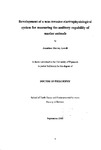Development of a non-invasive electrophysiological system for measuring the auditory capability of marine animals
| dc.contributor.author | Lovell, Jonathan Murray | |
| dc.contributor.other | Faculty of Science and Engineering | en_US |
| dc.date.accessioned | 2013-10-30T13:13:26Z | |
| dc.date.available | 2013-10-30T13:13:26Z | |
| dc.date.issued | 2005 | |
| dc.identifier | NOT AVAILABLE | en_US |
| dc.identifier.uri | http://hdl.handle.net/10026.1/2478 | |
| dc.description | Merged with duplicate record 10026.1/1293 on 27.02.2017 by CS (TIS) | |
| dc.description.abstract |
The following work describes the development and application of a neurological system to definitively profile the auditory responses of aquatic animals, presented as audiograms showing hearing threshold verses sound frequency. The accuracy of such information is essential for the optimisation of bio-technical devices such as the Acoustic Fish Deterrent (AFD) barrier deployed in the Illinois River to prevent the migration of non-indigenous Asian carp into Lake Michigan, and in the impact assessment of anthropogenic underwater sounds on the hearing of cetaceans and other marine animals. The ensuing Auditory Brainstem Response (ABR) electrophysiological recording technique developed at the University of Plymouth and described in this thesis is classified by the UK Home Office as being non-invasive, yielding high quality data from vertebrates in the absence of anaesthetics or implanted electrodes. The ABR technique was further refined to allow for the recording of evoked potentials in response to either the sound pressure or particle motion component of an acoustic signal, from animals stationed both at and below the water surface and ranging in size from a few millimetres to nearly a meter in length. The electrophysiological studies have resulted in the publication of three peer reviewed manuscripts, one of which is the first to define hearing for any animal from the order Acipenseriform (sturgeons and paddlefish). In addition to the development of the electrophysiology system and protocols, the inner ear morphology of the animals tested in this work were studied at the ultrastructural level, along with detailed descriptions of the afferent nerve pathway from the ear to the brain. Current literature shows a paucity of information on consistent and meticulous removal of inner ear parts necessary to identify damage to the ultrastructure that is symptomatic of hearing loss. In order for the acquisition of concise and reliable data, the dissection and preparation technique for Scanning Electron Microscopy (SEM) was refined for each species investigated and has resulted in the publication of a further three peer reviewed manuscripts on inner ear morphology. | en_US |
| dc.language.iso | en | en_US |
| dc.publisher | University of Plymouth | en_US |
| dc.title | Development of a non-invasive electrophysiological system for measuring the auditory capability of marine animals | en_US |
| dc.type | Thesis | |
| plymouth.version | Full version | en_US |
| dc.identifier.doi | http://dx.doi.org/10.24382/3987 |
Files in this item
This item appears in the following Collection(s)
-
01 Research Theses Main Collection
Research Theses Main


